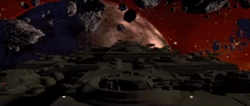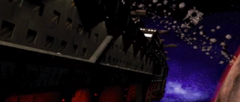
Turrets of several sizes adorn the Phobos' back.
The Phobos was one of two massive capital ships used by the TCM during the First Invasion of Stroggos, glimpsed in the introductory cut-scene of Quake II.
Heavily defended, bristling with cannons and launchers of various types across its back and belly, harboring a full Air Wing in its enormous landing bays, it carried hundreds, if not thousands of Drop Pods and their Marines to Stroggos in a desperate bid to forever end the Strogg threat to Mankind.
The Phobos is the flagship of Flag Admiral Crockett, and is known to be capable of both atmospheric and space flight. A remarkably versatile ship, it is easily able to fulfill multiple battlefield roles simultaneously. It can, for example, serve as a mobile command and intelligence center, air and spacecraft carrier, troop and supply ship, mobile heavy weapons platform and as an effective launchpad for invasions.
Active Service Record[]

A view of the Phobos, its guns trained on Stroggos its Pod launchers activating.
Designed, constructed, tested and brought into active service during the long years of the War against the Strogg, the Phobos probably saw some action prior to the invasion of Stroggos, although which and how many engagements it participated in is not known.
In order commence the retaliatory invasion of the Strogg home-world, the Phobos and its sister ship, the Deimos, travelled the vast distances to Stroggos in mere hours, by way of a Strogg Slipgate placed in Earth orbit many years earlier.
The invasion in which both the Phobos and the Deimos were to play such important roles seems at first glance unusual, until one remembers the airborne Paratroopers of 20th Century Earth warfare: individual soldiers dropped by parachute from a large airborne vehicle over a target zone. The Phobos and Deimos would launch their invasion force at the planet in small, specially designed, highly advanced and very expensive Drop Pods, from the relative safety of space.
The Pods would be stowed aboard ship in row upon row of specially designed launch tubes, the exit hatches of which would pepper the port and starboard sides of both ships. Their occupants would be loaded into them hours beforehand, while the ships were still on Earth. It is likely that the ships contained interior hangar facilities behind the launch tube arrays, for the repair of malfunctioning Pods, among other things. It isn't known whether the launch tubes served a dual purpose, if they were capable of loading and launching missiles, or whether spare Pods were held back in case the ship had to be evacuated in an emergency.
The idea was that because Stroggos' planetary defense systems could detect and shoot down anything over a few meters in length, the only way to successfully transport personnel en masse to the surface of the world was in the aforementioned Drop Pods. The Pods were necessarily small, only capable of carrying one Marine and a certain amount of equipment each, as well as holding all the necessary guidance and propulsion systems. The Pods would, by their design, be too small to detect, and in so being the TCM would get the drop on the enemy.

The Phobos' Drop Pod launch tubes coming online.
During the launch of the invasion, while all of the Phobos' Pods successfully jettisoned, the descent would not go so smoothly: One Marine reported his Pod being struck by another, which severely damaged his own Pod and sent him many miles off course (it actually saved his life). Another Marine, a Commando on a special mission, reported being clipped and sent spinning by a piece of rocky debris in the asteroid belt surrounding the planet, his life also being saved by the accident.
These isolated misfortunes were just the start, however, as the planetary defense systems were in fact online and very much aware of the invasion, and were about to play an important part in it coming inches from ruin. The role of the Phobos in the ground invasion's survival in the face of the almost incalculable odds stacked against it was tactical and intelligence-based, primarily focused on the dissemination of new orders and the latest intelligence among surviving squads and individual soldiers in the field. Eventually, it would become more involved as the planetary defenses came down and its Air Wing was dispatched to the world below.
Following the launch of their entire Drop Pod invasion forces, the Phobos' Command Center closely monitored activity on the surface, in addition to watching the life signals and positions of each Marine. Very soon, their sensors registered an enormous ElectroMagnetic Pulse (E.M.P.) coming from the Big Gun defense system. Commanders aboard ship radioed their Marines and alerted them to the situation, but it was already too late: the signals of entire squads quickly began going dead en masse.
As the disturbing ground situation was unfolding, and while Commanders were receiving and distributing orders and intelligence to the dwindling ground forces, the huge ships attempted to withdraw to a safe distance before Stroggos' planetary defense systems could get a lock on them. They were also too late, however, as the defenses already had them in their sights.
The Strogg, having anticipated the Human invasion, activated a key part of their planetary defense systems: the Gravity Well. Once online, it projected an enormous, powerful cone of artificially high gravity into space, which the huge engines of the Phobos weren't able to overcome.
New orders were sent from the Command ships to Marines on their way to (or already on) the planet's surface; to destroy the machine generating the artificial gravity well. Many of these men and women were either killed or captured.
Only one Marine given the new orders, Pvt. Stepchild, who had launched from the Deimos, was able to carry them to completion, after an arduous journey across the surface of Stroggos, through several very heavily defended surface and sub-surface facilities. He eventually succeeded in his mission, along the way stealing an experimental Strogg fighter in which he made good his escape back to his Command ship; the Deimos.
At the same time, several other surviving Marines were making their way across Stroggos towards their objectives, watched closely by Command (in which the mood must have been very tense). Numerous lone Marines and groups of survivors were killed in attempting to reach and take their objectives, and many others were taken captive, often never to be seen again. Other survivors following in their wake would bear witness to this, finding the fallen bodies of their comrades strewn all about the facilities they had hoped to take.
It isn't known how many Marines the Phobos managed to recover from Stroggos during and following the first invasion, but given that the ship was broadcasting messages to planetside survivors stating that just 5% of the total ground force was still operational soon after the invasion was launched does not auger well.
Current Status[]
The current status of the Phobos is unknown, presumed withdrawn from the combat theater allowing the newest Carrier and Destroyer to take part on The Second Invasion of Stroggos.
Trivia[]
- In ancient Greek culture, Phobos was the God of horror, fear and terror. Twin brother of Deimos, he was often seen accompanying his father, Ares (the God of War), into battle. The term "phobia" is derived from Phobos' name.
- Phobos is the name of one of Mars' two asteroid moons.
- The moon Phobos was the setting for Episode 1, Knee-Deep in the Dead, of the famous Doom series of games, also created by id Software.
